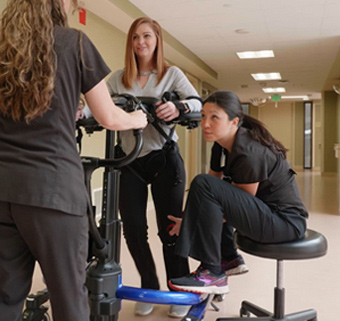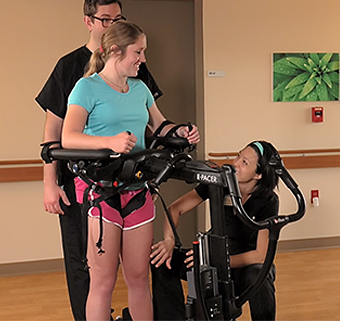Beyond the Walker
| November 2011Minnesota Clinic gets Better Outcomes from Smarter Gait Training than from Traditional Quad Walkers
Contributed by Nicole Grant, PT Courage Center, Golden Valley, MN
 As a physical therapist here at Courage Center in Golden Valley, Minnesota, I see many adult patients with significant motor deficits. For gait training, traditional four-wheeled walkers and rolling platform walkers provide stability, but not enough support to enable walking for functional distances. Patients often have to sit down on a chair to rest or be transferred back to the mat table, which cuts into their therapy time.
As a physical therapist here at Courage Center in Golden Valley, Minnesota, I see many adult patients with significant motor deficits. For gait training, traditional four-wheeled walkers and rolling platform walkers provide stability, but not enough support to enable walking for functional distances. Patients often have to sit down on a chair to rest or be transferred back to the mat table, which cuts into their therapy time.
But with Rifton’s Pacer gait training equipment, therapy is different. The Pacer has a wider base of support for stability, and using the hip positioner “saddle,” the client can sit down to rest as needed. That means the therapist doesn’t have to worry about the client tipping over or their knees buckling, and the patient can tolerate gait training for longer distances. Unlike a traditional forward wheeled walker, the Pacer increases gait practice time and standing tolerance by taking some of the burden off the therapist.
Because of this capability, we view the Pacer increasingly as a tool in therapy for lower extremity strengthening and balance training in our clinic. The 25 therapists we have here on staff use large Pacers for diverse clients. In any given eight-hour day, they are in use for two to three hours.
Use of the Pacer in Medical Facilities: Becoming a Walker More Quickly
In the Pacer our patients are better supported and some can sustain walking practice of up to 1000 feet or more. Even for a client who cannot yet take steps, we’ll work on the sit-to-stand action for muscle strengthening, providing cues at the lower extremities.
Unlike using quad walkers without support, while using a Pacer patients are improving strength in their legs, trunk, and even in their arms as they are steering. These strength gains help with their transfers and carry over to making their ADLs and other activities more independent. I have used the Pacer with such diagnoses as incomplete spinal cord injury, traumatic brain injuries, acquired brain injury such as stroke, cerebellar disorders, brain tumors and cerebral palsy.
Smooth Transitions on Four Wheels: Prompts Help a Walker Gain Momentum
The goal of the Pacer is to ambulate with fewer and fewer prompts. Thus each prompt is removable for the purpose of progression.
For example, as a patient’s legs get stronger, we can temporarily remove the hip positioner while using the arm and chest prompts. The saddle will be hanging right on the Pacer ready to use when needed. We’ll say to the patient, “OK, we’re going to walk forward 100 feet without the saddle, and then we’re going to put it back on if you’re fatigued.” We can’t do that with a typical four-wheeled walker.
We can also remove accessory prompts to work on balance. With the arm or chest prompts removed temporarily, the client can be standing, reaching and self-stabilizing without dependence on prompts.
Because the prompts allow from full to zero weight bearing by the client, it is even possible to place a person without active use of their trunk and leg muscles into the Pacer. I have used it successfully with incomplete cervical spinal cord injury for a client with quadriplegia and all four extremities affected, and also with incomplete paraplegic SCI, where there is full arm strength but the legs are affected.
Gait Training Success for Diverse Clients
One patient who had sustained a cervical spinal cord injury used a Pacer extensively outside the clinic with the help of his personal care assistant. He found it to be a real benefit in his rehab. This patient progressed to independently taking steps with knee-ankle-foot-orthoses while in the Pacer for distances of up to 50 feet at a time, with some cueing at the trunk and stand-by assist of his PCA.
 We have had adults with cerebral palsy come to the clinic who have not walked since they were kids because they haven’t had a 4 wheeled walker or other device that was supportive enough for them. Even those with significant physical limitations can be put into a modified standing position and placed in the Pacer for gait, balance, and strength training.
We have had adults with cerebral palsy come to the clinic who have not walked since they were kids because they haven’t had a 4 wheeled walker or other device that was supportive enough for them. Even those with significant physical limitations can be put into a modified standing position and placed in the Pacer for gait, balance, and strength training.
The Pacer has also been great for populations with ataxia. I have a client right now who is ataxic and cannot control a regular quad walker herself. But in the Pacer with stand-by assist of the therapist guiding the frame and giving cues at the hip positioner and trunk, she is able to walk more than 1000 feet over level and varied terrain.
We have seen other remarkable outcomes. One gentleman with ataxia could walk in the Pacer at the clinic for up to a half-hour. After this gait training, he was able to use his Loftstrand crutch to go in and out of vehicles and to walk down a portion of the sidewalk without loss of balance. The Lofstrand is more practical for him during the day, while the Pacer training improves his strength for ADLs.
No Need to Put on the Brakes: Continuing Gait Training Using the Pacer at Home
Over the two years since we have had the Pacer at our clinic, we have probably ordered 10–12 for clients to use at home. Our clients who use the Pacer at home typically use it for gait training or exercise.
While it can be a challenge to obtain funding for adaptive equipment for home use, we have been able to justify it as a device that will enable daily active rehab at home vs. weekly at our clinic. The cost benefit is what has convinced the insurance provider.
By using the Pacer for four-wheeled, supported walking, patients build strength and independence. They also get the satisfaction of being upright and walking and accomplishing a goal.
Nicole Grant graduated from the College of St. Scholastica in Duluth, Minnesota, with her Master of Arts/Physical Therapy in 2005. She has been working at the Courage Center in Golden Valley, MN since January 2006 where she focuses her rehabilitation on the neurologically involved population both in the clinic and the pool.
She also obtained her Assistive Technology Practitioner Certificate in January 2008, as she is the Lead Therapist with the Mobility and Seating Program.




